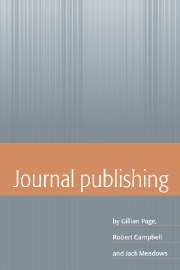Book contents
- Frontmatter
- Contents
- List of figures
- List of tables
- Preface
- 1 Introduction to journals
- 2 Editing
- 3 Production
- 4 Marketing
- 5 Subscription management and distribution
- 6 Non-subscription revenue
- 7 Legal and ethical aspects
- 8 Financial aspects
- 9 Bibliographic aspects
- 10 Managing a list of journals
- 11 Electronic publishing
- Appendix 1 Getting tenders for journals
- Appendix 2 Publishers' and editors' associations
- Glossary
- Bibliography
- Index
9 - Bibliographic aspects
Published online by Cambridge University Press: 23 October 2009
- Frontmatter
- Contents
- List of figures
- List of tables
- Preface
- 1 Introduction to journals
- 2 Editing
- 3 Production
- 4 Marketing
- 5 Subscription management and distribution
- 6 Non-subscription revenue
- 7 Legal and ethical aspects
- 8 Financial aspects
- 9 Bibliographic aspects
- 10 Managing a list of journals
- 11 Electronic publishing
- Appendix 1 Getting tenders for journals
- Appendix 2 Publishers' and editors' associations
- Glossary
- Bibliography
- Index
Summary
Introduction
The object of good bibliographical practice is to make it easy for readers to use journals and to keep the cost of handling them to a minimum. Divergence from common custom confuses and irritates librarians, subscription agents and bibliographers; it may deter or confuse potential purchasers and delay the appearance of the journal on the library shelves. Many libraries have automated systems which refuse to function if not fed the appropriate data: for instance, every serial record may require an International Standard Serial Number (ISSN). One indication of the scale of the problem is that ISI (The Institute of Scientific Information) has a full-time member of staff recording and checking title changes, splits and mergers. This chapter discusses the basic bibliographic decisions which have to be made in journal publishing and makes recommendations where appropriate.
Mostly this is logical and straightforward, though not necessarily selfevident: few publishers get it right every time. It is foolish to invent a new way of doing things, if the customary method is satisfactory. In case of doubt, it is useful to check the practice of the leading journals in the same subject area. Two general principles can help to avoid some of the most common pitfalls. One is that journals are handled by clerical staff in publishing houses, subscription agents and libraries: they may be expert in handling subscriptions, but are unlikely to know anything of the subject matter of the journals they handle.
- Type
- Chapter
- Information
- Journal Publishing , pp. 301 - 320Publisher: Cambridge University PressPrint publication year: 1997



